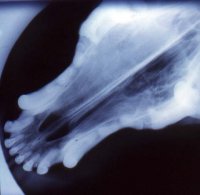 Back
Back
ASPERGILLOSIS IN DOGS AND CATS First broadcast on www.provet.co.uk |
This information is provided by Provet for educational purposes only.
You should seek the advice of your veterinarian if your pet is ill as only he or she can correctly advise on the diagnosis and recommend the treatment that is most appropriate for your pet.
Aspergillosis is a relatively common disease in long-nosed dogs, and occasionally causes lung disease or intestinal disease in cats.
Aspergillus fumigatus is a fungus infection which is often seen affecting the nasal cavity of long-nosed dogs. It is an unpleasant infection to have because it causes discomfort and sneezing, it can cause significant damage to the lining and bony structures within the nasal cavity, and it can be a very difficult condition to treat.
The signs associated with aspergillus infection in the nose are :
- Blood or blood-stained pus discharging from the nostril (usually only one-side of the nose is affected)
- Ulcers around the rim of the nose
- Pain
- Sneezing
The precise mechanism of infection is not known in all cases, but presumably the fungal spores are sniffed up into the nose from the surrounding environment eg soil. In dogs the infection usually localizes in the nose and does not spread elsewhere, but in cats the infection causes a generalised disease involving the lungs (pneumonia) or the intestine.
Animals that have a poor immune response are at greater risk to contract the infection than animals with a normal immune response.
The clinical signs caused by aspergillosis are also caused by cancers in the nose - so getting an accurate diagnosis is very important.
On X-Rays one side of the nasal cavity becomes filled with fluid (which appears to be grey) and the normal bony pattern is lost (see the X-Ray picture above). Unfortunately similar X-Ray changes occur with other diseases (including cancer), so a variety of laboratory tests are needed to confirm that aspergillosis is the cause of the problem.
Treatment involves the administration of antifungal agents. In dog noses the infection is within a cavity so it can be difficult to get a 100% cure, and in the worst affected cases tubes have to be surgically placed into the nasal cavity, or into the frontal sinuses of the skull so that the medication can be flushed through the nose.
In cats with generalised disease there is little likelihood of treatment being successful and the prognosis is poor. Diagnosis is usually confirmed at post-mortem
Last updated : March 2008
